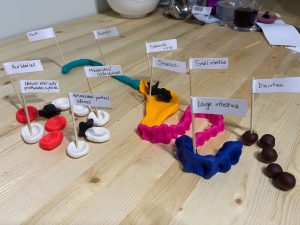How does food poisoning affect the digestive and immune system?
Bacteria is often the most common cause of food poisoning. One of the most common forms of food poisoning is salmonella because it can survive the harsh environment of the stomach and affects the body in many different ways, some of which are the physical effects including diarrhea, vomiting, fever, body aches, stomach pain, and overall discomfort. Two of the systems that are primarily affected by food poisoning are the digestive system and the lymphatic system. The lymphatic system alerts the body of a forigen contaminant, it attempts to protect the body with its autoimmune response, while the digestive system tries to process the toxin it’s taking in.
Let’s say you have a tasty roasted chicken for dinner but it wasn’t quite cooked to temperature and wasn’t stored in the proper manner prior to cooking. The bacterium salmonellosis is what would invade your body after ingesting tainted meat which triggers the immune system to release several different cells and chemicals into defense to protect itself from infection. Once the enterotoxins enter the gut linings deeper tissues, phagocytes, natural killer cells, antimicrobial proteins, and proinflammatory cytokines are activated. The virus or bacteria starts to present food poisoning symptoms because the body is trying to filter it out.
The white blood cells that fight forgien bacteria are known as phagocytes. Phagocytes are broken into two main groups of neutrophils being the weaker cell, and macrophages which develop monocytes and are the stronger phagocytes. Natural killer cells are non phagocytic and proinflammatory cytokines, they travel through the blood and lymph tissue attacking forigen toxins and kill virus infected cells through apoptosis, lastly they secrete chemicals to increase the inflammatory response. Inflammation is the body’s reaction to tissue injury, with food poisoning specifically it would be due to infections microorganisms, although inflammation can be painful and irritating to us it has its benefits. Inflammation in the lymph tissue is one of the body’s first red flags to infection, it helps prevent the spread of damaging pathogens, and sets the body up to repair itself. There are two main types of antimicrobial proteins, inferons which when infected with a virus like food poisoning can alert other healthy cells of the presence of the virus, stimulating proteins that keep the virus from reproducing. Infrons also activate natural killer cells and macrophages. The other antimicrobial proteins are complement proteins, there are about 20 different types that circulate throughout our body, when they are activated they increase inflammation, innate, and adaptive defenses as well as directly destroy bacteria.
The intestinal wall is where the bacterial toxins are absorbed into their pores, this causes excess water to be released into the intestinal tract in order to promote healing which ultimately is what causes diarrhoea, a common symptom that most people experience during food poisoning. Some bacteria cause vomiting from food poisoning which some researchers believe that these bacteria stimulate the vagus nerve within the brain, this is the brain’s vomiting center. Fever is usually the last symptom associated with food poisoning, macrophages exposed to forigen bacteria secrete pyrogens, these cells ignite the hypothalamus and raise the body temperature in the attempt to increase the metabolic rate to encourage cellular repair.
Ultimately to keep yourself safe from food poisoning like salmonella, insure to keep your meat stored at cool temperatures, keep clean and hygienic food preparation procedures, and make sure to cook your food up to optimum temperature before consuming it.
Citations:
“What Happens in My Body When I Get Food Poisoning?” BBC Science Focus Magazine, www.sciencefocus.com/the-human-body/what-happens-in-my-body-when-i-get-food-poisoning/.
“Treatment for Food Poisoning.” National Institute of Diabetes and Digestive and Kidney Diseases, U.S. Department of Health and Human Services, www.niddk.nih.gov/health-information/digestive-diseases/food-poisoning/treatment.
“Salmonella Infection.” Mayo Clinic, Mayo Foundation for Medical Education and Research, 11 Oct. 2019, www.mayoclinic.org/diseases-conditions/salmonella/symptoms-causes/syc-20355329#:~:text=Salmonella%20bacteria%20typically%20live%20in,within%20eight%20to%2072%20hours.



Haley did her STEAM Project on how food poisoning affects the digestive and immune system. She made a labeled model on foreign toxins and bacterium entering the body in the digestive system. She talks about one of the most common forms of food poisoning, which is salmonella and how it affects the body. The two systems most affected by food poisoning are the digestive and lymphatic system. Ingesting the bacterium would trigger the immune system to release cells to protect the body from infection. She explains how phagocytes, a type of white blood cell that fights foreign bacteria, travel through the body and lymph tissue to fight off toxins. Inflammation prevents pathogens from spreading and sets the body up to repair itself. She also explains the reasoning behind some symptoms of food poisoning, such as vomiting, fever, and diarrhea. Most people experience diarrhea during food poisoning because bacterial toxins are absorbed in the intestinal wall, which causes the release of water. Vomiting by food poisoning is believed to be caused by bacteria stimulating a nerve in the brain that triggers it. To prevent getting food poisoned, meat should be stored in cool temperatures, cooked at the correct temperature, and hygienic food preparation should be used. I think she did a good job with her project and I learned something new about the reasons why we get those symptoms after food poisoning.
I really like this topic about How does food poisoning affect the digestive and immune system, it has a lot of great info, thanks for sharing this informative info